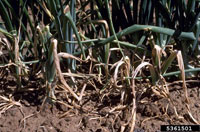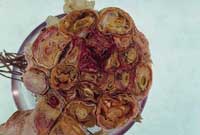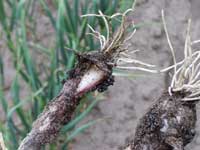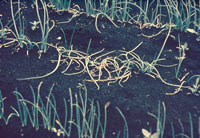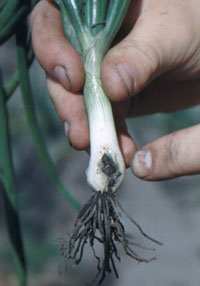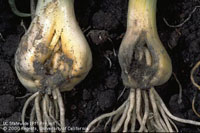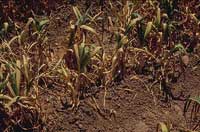Extension > Garden > Diagnose a problem > What's wrong with my plant? > Vegetable > Garlic > Leaves yellow then wilt
Garlic > Leaves > Leaves yellow then wilt
1 of 8
Fusarium basal rot
Fusarium oxysporum f.sp. cepae
- Leaves turn yellow to brown from the tip down and wilt
- Red to purple discoloration may be seen on bulbs early in the season
- Bulb has watery brown decay starting at the base and extending up into the bulb
- A white fuzzy growth can often be seen on the rotted basal plate
- More information Fusarium Basal Rot
2 of 8
Penicillium decay
Penicillium hirsutum
- Young plants are stunted, yellow, and wilted
- Infected cloves rot before emergence, resulting in poor stand establishment
- Plants remain weak and thin throughout season
- Cloves have a blue-green fuzzy fungal growth
- More information on Penicillium Decay
3 of 8
Botrytis neck rot
Botrytis porri
- Outer leaves yellow and die back, in severe cases the entire plant dies
- Stem (neck) appears water soaked at the soil line
- Small, hard, black fungal structures form in the decayed stem tissue
- Rot may extend into the top of the bulb in severe cases
- Disease is common in cool wet weather or in heavy wet soils
- More information on Botrytis Neck Rot
4 of 8
White rot
Sclerotium cepivorum
- In severely infected plants, leaves may be stunted, yellow from the tip down, and die
- Bulb is soft and rotten from the base up
- Bulb has white, fluffy fungal growth
- Small, hard, black poppy seed like fungal structures form on infected bulbs
- Roots may be rotten or completely rotted away
- More information White Rot
5 of 8
Onion maggot
Delia antiqua
- Plants yellow and wilt, sometimes rapidly
- Holes in bulbs are present
- Maggots may be present; they are carrot-shaped, legless, and cream colored
- More information on Onion Maggot
6 of 8
Pink root
Phoma terrestris
- Leaves turn yellow with a reddish tinge from the tip down due to root damage
- Sunken dark pink to maroon areas on roots
- Infected roots break off easily
- Plants are stunted and may produce no to very small bulbs
- Commonly occurs mid to late season, in areas with poor soil
- More information on Pink Root
7 of 8
Nitrogen deficiency
- Tips of leaves are yellow
- Entire plant appears pale green to yellow
- Stems are thin
- More information on Nitrogen Deficiency
8 of 8
Stem and bulb nematode
Ditylenchus dipsaci
- Base of stem (neck) of plant is soft, eventually wilts
- Plants appear distorted
- Plants are stunted with shortened and thickened leaves
- Bulbs are often desiccated and light weight, secondary rot organisms like soft rot may invade and rot the bulb
- More information on Stem and Bulb Nematode



